
Nepal measures about 880 kilometers (547 mi) along its Himalayan axis by 150 to 250 kilometers across. It has an area of 147,516 km2 (56,956 sq mi).

The Ghaghara River, called Karnali River in Nepal, Mapcha Tsangpo in Tibet, and the lower Ghaghara in Awadh called Saryu River, is a perennial trans-boundary river that originates in the northern slopes of the Himalayas in the Tibetan Plateau, cuts through the Himalayas in Nepal and joins the Sharda River at Brahmaghat in India. Together they form the Ghaghara River, a major left bank tributary of the Ganges. With a length of 507 km (315 mi) it is the longest river in Nepal. The total length of Ghaghara River up to its confluence with the Ganges at Revelganj in Bihar is 1,080 km (670 mi). It is the largest tributary of the Ganges by volume and the second largest by length after Yamuna.

The Ganges Basin is a part of the Ganges-Brahmaputra-Meghna (GBM) basin draining 1,999,000 square kilometres in Tibet, Nepal, India and Bangladesh. To the north, the Himalaya or lower parallel ranges beyond form the Ganges-Brahmaputra divide. On the west the Ganges Basin borders the Indus basin and then the Aravalli ridge. Southern limits are the Vindhyas and Chota Nagpur Plateau. On the east the Ganges merges with the Brahmaputra through a complex system of common distributaries into the Bay of Bengal. Its catchment lies in the states of Uttar Pradesh (294,364 km2), Madhya Pradesh (198,962 km2), Bihar (143,961 km2), Rajasthan (112,490 km2), West Bengal (71,485 km2), Haryana (34,341 km2), Himachal Pradesh (4,317 km2), Delhi, Arunachal Pradesh (1,484 km2), the whole of Bangladesh, Nepal and Bhutan. Several tributaries rise inside Tibet before flowing south through Nepal. The basin has a population of more than 500 million, making it the most populated river basin in the world.

The Gandaki River, also known as the Narayani and the Gandak, is one of the major rivers in Nepal and a left bank tributary of the Ganges in India. Its total catchment area amounts to 46,300 km2 (17,900 sq mi), most of it in Nepal. In the Nepal Himalayas, it is notable for its deep canyon. The basin also contains three mountains over 8,000 m (26,000 ft), namely Dhaulagiri, Manaslu and Annapurna I. Dhaulagiri is the highest point of the Gandaki basin.

The Kosi or Koshi is a transboundary river which flows through China, Nepal and India. It drains the northern slopes of the Himalayas in Tibet and the southern slopes in Nepal. From a major confluence of tributaries north of the Chatra Gorge onwards, the Kosi River is also known as Saptakoshi for its seven upper tributaries. These include the Tamur River originating from the Kanchenjunga area in the east and Arun River and Sun Kosi from Tibet. The Sun Koshi's tributaries from east to west are Dudh Koshi, Likhu Khola, Tamakoshi River, Bhote Koshi, and Indravati. The Saptakoshi crosses into northern Bihar, India where it branches into distributaries before joining the Ganges near Kursela in Katihar district.
The 2008 Indian floods were a series of floods in various states of India during the 2008 monsoon season. The floods mostly affected the western regions of Maharashtra state and Andhra Pradesh as well as northern Bihar. In India, the monsoon season generally lasts from June to September.
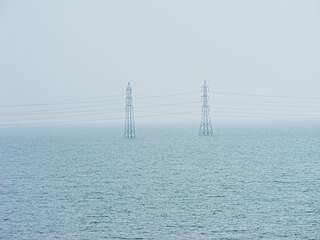
The 2008 Bihar flood was one of the most disastrous floods in the history of Bihar, an impoverished and densely populated state in India. The Koshi embankment near the Indo-Nepal border broke on 18 August 2008. The river changed course and flooded areas which had not been flooded in many decades. The flood affected over 2.3 million people in the northern part of Bihar.

The Koshi Barrage is a sluice across the Koshi river that carries vehicular, bicycle, and pedestrian traffic between Saptari district and Sunsari district of Nepal. It is near the International border with India. It was built between 1958 and 1962 and has 56 gates. It was constructed after the Koshi Agreement was signed between the Government of Nepal and India on April 25, 1954. The barrage was designed and built by Joseph and Company Limited, India. The Koshi Tappu Wildlife Reserve is roughly 3–4 miles north of the barrage.
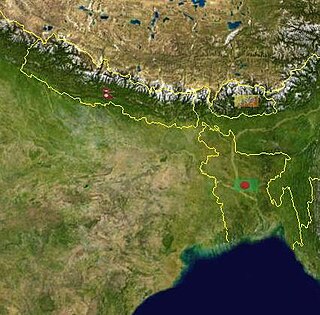
Bihar is located in the eastern region of India, between latitudes 24°20'10"N and 27°31'15"N and longitudes 83°19'50"E and 88°17'40"E. It is an entirely land–locked state, in a subtropical region of the temperate zone. Bihar lies between the humid West Bengal in the east and the sub humid Uttar Pradesh in the west, which provides it with a transitional position in respect of climate, economy and culture. It is bounded by Nepal in the north and by Jharkhand in the south. Bihar plain is divided into two unequal halves by the river Ganges which flows through the middle from west to east. Bihar's land has average elevation above sea level of 173 feet.
The 2007 Bihar flood, which started in August 2007, was described by the United Nations as the worst flood in the "living memory" of Bihar. It is believed to be the worst flood in Bihar in the last 30 years. By 3 August, the estimated death toll was 41 people, and 48 schoolgirls were marooned in a school in the Darbhanga district. By 8 August, the flooding had affected an estimated 10 million people in Bihar. Army helicopters delivered food packets to Bihar residents and 180 relief camps were established. By 10 August, aid workers in Bihar reported that there was a dramatic increase of people with diarrhoea and by 11 August, flood deaths were still occurring. Total deaths recorded in 2007 Bihar floods was 1,300+, which was second highest death toll in state after 2,500+ deaths in 1987 Bihar floods.
The 2004 Bihar flood was one of the worst floods in Bihar, India in a decade. 885 people and 3272 animals had lost their lives and nearly 21.299 million human were affected. 20 districts of Bihar were affected. An alarming rise in water level due to heavy rains inundated fresh areas in Bhagalpur district, Begusarai district, Katihar district, Darbhanga district, Samastipur district and Khagaria district. According to the Central Water Commission Bagmati, Budhi Gandak, Kamla Balan, Adhwara, Kosi and Mahananda rivers were flowing above the red mark at various places, while the Ganges crossed the danger mark for the first time at Farakka Barrage.
The Koshi embankments were built in late 1950s to retain the Kosi River which is a transboundary river between Nepal and India and is one of the largest tributaries of the Ganges. It was conceptualised during the first Bihar Government of CM Shri Babu and his deputy Anugraha Babu. According to the agreement with Nepal, the responsibility of maintaining these embankments was vested in the Government of Bihar.
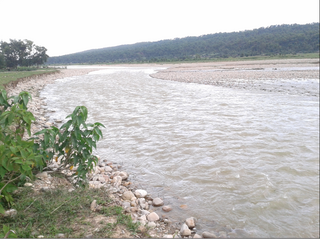
The Kamala River originates from Nepal and flows through Indian state of Bihar.
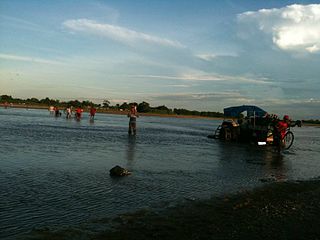
The Mechi River is a trans-boundary river flowing through Nepal and India. It is a tributary of the Mahananda River.

The Sunkoshi, also spelt Sunkosi, is a river of Nepal that is part of the Koshi or Saptkoshi River system in Nepal. Sunkoshi has two source streams, one that arises within Nepal in Choukati, and the other more significant stream that flows in from Nyalam County in the Tibet region of China. The latter is called Bhote Koshi in Nepal and Matsang Tsangpo in Tibet. Due to the significant flows from Bhote Koshi, the Sun Koshi river basin is often regarded as a trans-border river basin.
The Chatra Gorge is a canyon cut by the Kosi River across the Mahabharat Range in Nepal.
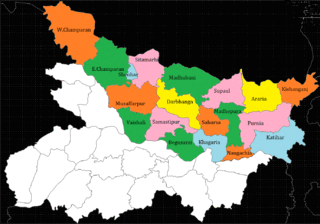
North Bihar is a term used for the region of Bihar, India, which lies north of the Ganga river.

2017 Bihar floods affected 19 districts of North Bihar causing death of 514 people. 2,371 panchayats under 187 blocks of 19 districts of Northern Bihar have been affected in the flood. Around 1.71 crore people were hit by the floods. Over 8.5 lakhs of people have lost their homes, with Araria district alone accounting for 2.2 lakh homeless people. 2017 Flood has broken 9-Year record of deaths In Bihar. Bihar is India's most flood-prone State, with 76% of the population in the North Bihar living under the recurring threat of flood devastation. Devastating flood was caused due to excess heavy rainfall in monsoon season.
River bank erosion along the Ganges in Malda and Murshidabad districts focusses on river bank erosion along the main channel of the Ganges in Malda and Mushidabad districts of West Bengal, India.
Saptakosi High Dam, also called Koshi High Dam, is a multipurpose project proposed to be constructed on the Saptakoshi River of Nepal. The project is primarily aimed to control floods in south-east Nepal and northern Bihar of India, and to generate hydro power. An issue subsequently coming with this project is Nepal’s access to sea port via 165 km long navigation canal linking to Calcutta sea port through River Ganges.



















